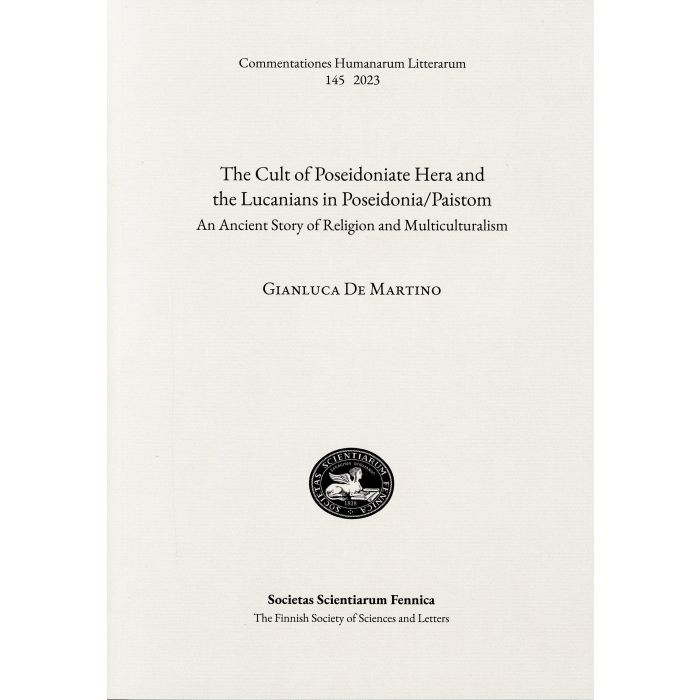We use cookies to make your experience better. To comply with the new e-Privacy directive, we need to ask for your consent to set the cookies. Learn more.
Cult of Poseidoniate Hera and the Lucanians in Poseidonia/Paistom
Special Price
€24.00
Regular Price
€30.00
In stock
SKU
978-951-653-496-4
De Martino, Gianluca
The Cult of Poseidoniate Hera and the Lucanians in Poseidonia/Paistom. An Ancient Story of Religion and Multiculturalism
Finska Vetenskaps-Societeten - Suomen Tiedeseura
Commentationes Humanarum Litterarum 145
Vaasa 2023, 329 pp.
The Cult of Poseidoniate Hera and the Lucanians in Poseidonia/Paistom. An Ancient Story of Religion and Multiculturalism
Finska Vetenskaps-Societeten - Suomen Tiedeseura
Commentationes Humanarum Litterarum 145
Vaasa 2023, 329 pp.
The subject of this work is the cult of goddess Hera in the Greek colony of Poseidonia, in Southern Italy. The work focuses on the process through which the local Italic Lucanians preserved and continued the cult after they had taken control of the city from the Greeks sometime between 420 and 410 BCE.
Archaeological material, such as votive clay figurines, and the topographical and architectural features of several cultic places were employed as the primary data sources. By combining evidence from the iconographic typologies of the clay figurines and the topography and the architecture of both Greek and Lucanian sanctuaries, this work postulates that the absorption and the reshaping of the cult of Hera was a natural process for the Lucanians, since they had long had deities who shared the same attributes as Hera in their own religion.
This process was facilitated by the fact that several Lucanian female deities, and particularly Mefitis, the main goddess of Lucanian religion, shared similar attributes with Poseidoniate Hera. Comparing the votive figurines recovered from Paestan sanctuaries dedicated to Hera and the topographical features of her sanctuaries to the main features of Lucanian cultic places, and to the iconography of votive gifts dedicated in Lucanian sanctuaries, this research suggests that widely shared religious similarities enabled the continuation of the cult of Hera in Poseidonia/Paestum.
Concerning ritual practices, the increase in common ritual dining was the result of the arrival of chthonic cults in Lucanian Paestum, or at least the addition of chthonic aspects typical of the agrarian and chthonic cults of the Lucanian inland to existing Greek cults. This was true for the cult of Hera as well. The archaeological evidence suggests the arrival of Lucanian rural chthonic religious practices connected with common ritual dining in the form of bone finds related to chthonic cults (dogs, cockerels), the development of peculiar forms of incense burners, and the presence of sacrificial pits and water channels associated with altars.
The cult of Hera thrived throughout the Greek and Lucanian periods until the foundation of the Roman colony of Paestum in 273 BCE, when it was incorporated into the cult of the Capitoline Triad and gradually lost its primacy to cults favoured by the new Roman colonists.
Archaeological material, such as votive clay figurines, and the topographical and architectural features of several cultic places were employed as the primary data sources. By combining evidence from the iconographic typologies of the clay figurines and the topography and the architecture of both Greek and Lucanian sanctuaries, this work postulates that the absorption and the reshaping of the cult of Hera was a natural process for the Lucanians, since they had long had deities who shared the same attributes as Hera in their own religion.
This process was facilitated by the fact that several Lucanian female deities, and particularly Mefitis, the main goddess of Lucanian religion, shared similar attributes with Poseidoniate Hera. Comparing the votive figurines recovered from Paestan sanctuaries dedicated to Hera and the topographical features of her sanctuaries to the main features of Lucanian cultic places, and to the iconography of votive gifts dedicated in Lucanian sanctuaries, this research suggests that widely shared religious similarities enabled the continuation of the cult of Hera in Poseidonia/Paestum.
Concerning ritual practices, the increase in common ritual dining was the result of the arrival of chthonic cults in Lucanian Paestum, or at least the addition of chthonic aspects typical of the agrarian and chthonic cults of the Lucanian inland to existing Greek cults. This was true for the cult of Hera as well. The archaeological evidence suggests the arrival of Lucanian rural chthonic religious practices connected with common ritual dining in the form of bone finds related to chthonic cults (dogs, cockerels), the development of peculiar forms of incense burners, and the presence of sacrificial pits and water channels associated with altars.
The cult of Hera thrived throughout the Greek and Lucanian periods until the foundation of the Roman colony of Paestum in 273 BCE, when it was incorporated into the cult of the Capitoline Triad and gradually lost its primacy to cults favoured by the new Roman colonists.
| Publisher | Finnish Society of Sciences and Letters |
|---|---|
| ISBN | 978-951-653-496-4 |
| ISSN | 0069-6587 |
| Series | Commentationes Humanarum Litterarum |
| Published (year) | 2023 |
| Cover | Softcover |
| Type of Binding | Softcover binding |
| Languages | english |
| Disciplines | Classical Studies, Archaeology, History, Cultural Studies, Religious Studies |


